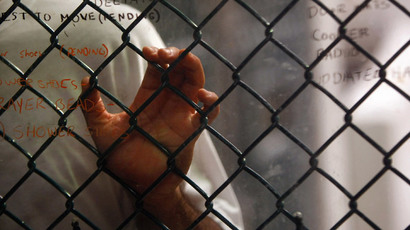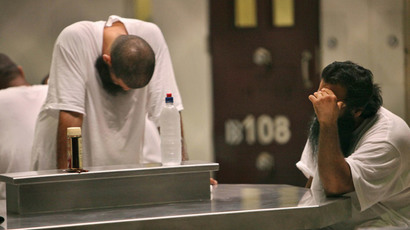Gitmo detainees fight destruction of force-feeding footage

Hunger-striking detainees in Guantanamo Bay are seeking a federal injunction to stop prison authorities from destroying newly-unearthed force-feeding videos. The move follows reports increasingly harsh punishments are being meted out to hunger-strikers.
Hunger-striking detainees in Guantanamo Bay are seeking a federal injunction to stop prison authorities from destroying newly-unearthed force-feeding videos. The move follows reports increasingly harsh punishments are being meted out to hunger-strikers.
The military-produced recordings were first uncovered during the course of litigation in Washington, DC’s, Federal District court in an attempt to halt abusive force-feeding, prisoners’ rights group Reprieve reports.
The filing has asked the judge to issue an emergency order to the military requiring it to preserve the tapes.
"Right now we are very concerned that someone in government or the military might be acting quickly to destroy the force feeding videotapes, and we have asked the court to make sure that doesn't happen," Jon Eisenberg, co-counsel from Reprieve, said.
The urgency of the request follows a December 2007 motion, in which the American Civil Liberties Union (ACLU) asked that the CIA be held in contempt for the destruction of a dozen video tapes depicting so-called "enhanced interrogation techniques."
Cori Crider, Reprieve’s strategic director and counsel to the detainees, said “Gitmo’s riot squad hauling prisoners to force-feeding is some of the worst that is going on there right now, and we were stunned to learn some of it has been filmed. We can’t let this evidence go the way of the waterboarding tapes – they might well be at the heart of the upcoming trial of Gitmo’s brutal force-feeding practices.”
Reprieve says the latest legal challenge follows the organization’s initial force-feeding case, Aamer v Obama, in which the DC Court of Appeals ruled in February that the courts have subject-matter jurisdiction over detainee challenges to conditions of confinement.
During the course of the trial, a myriad of abuses came to light during the course of enteral, or tube-feeding, including detainees being left to defecate in restraint chairs, the often rough insertion and removal of long feeding tubes, and expedited force-feeding which vastly exceed accepted medical standards.
“The tapes are likely to show Guantánamo’s ‘Forcible Cell Extraction’ (FCE) team transporting hunger-striking detainees who refuse (or are too weak) to walk to the force-feeding chair,” Reprieve said in a statement on Wednesday.
“This process, in which a team of military police in riot gear storm a prisoner’s cell and ‘subdue’ him, has long been criticized as abusive. In 2003, USAF Spc. Sean Baker suffered permanent brain damage during a cell extraction training exercise. He was playing the role of the detainee.”

‘He’s 80lbs with 1 broken arm’
Meanwhile, Emad Hassan, a detainee at Guantanamo, told his lawyers that camp authorities are dishing out increasing harsh punishments to break the will of the remaining hunger strikers.
“One Yemeni is 80lbs and he was brought to his feeding by the Forced Cell Extraction (FCE) team, Guantánamo's official riot police. Yesterday the FCE team beat him when they came into and out of his cell. He is 80lbs with one broken arm. He cannot walk, just crawl from his bed to the faucet or toilet once he needs to use it! How can someone with this condition fight eight armed guards?” Hassan wrote in a letter to his lawyers.
“As I write now, [a detainee] is vomiting on the torture chair, having been brought there by the Forced Cell Extraction (FCE) team. The nurse and corpsman have refused to stop the feed, or to slow the acceleration of the liquids.”
Like many of the detainees Emad, a Yemeni citizen, has never been charged with a crime. He has been on hunger strike since 2007 and was cleared for release the same year.
According to Reprieve, the number of detainees still on hunger strike to protest camp conditions is approximately 17. Authorities at the camp instituted a virtual media blackout in December, as releasing official figures was reportedly generating too much media attention.
The hunger strike, which reached its peak in June 2013, forced US President Barack Obama to repeat previous vows to shutter the facility, which presently holds 154 inmates.














